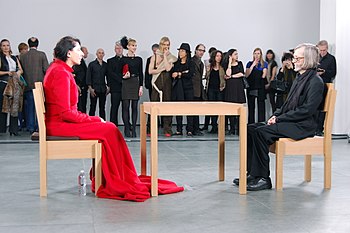
Back فن التحمل Arabic Arte de resistencia Spanish Տոկունության արվեստ Armenian Arta de anduranță Romanian Искусство выносливости Russian


Endurance art is a kind of performance art involving some form of hardship, such as pain, solitude or exhaustion.[2] Performances that focus on the passage of long periods of time are also known as durational art or durational performances.[3]
Human endurance contests were a fad of Depression-era America from the 1920s-1930s.[4] Writer Michael Fallon traces the genre of endurance art to the work of Chris Burden in California in the 1970s.[5] Burden spent five days in a locker in Five Day Locker Piece (1971), had himself shot in Shoot (1971), and lived for 22 days in a bed in an art gallery in Bed Piece (1972).[6]
Other examples of endurance art include Tehching Hsieh's One Year Performance 1980–1981 (Time Clock Piece), in which for 12 months he punched a time clock every hour, and Art/Life One Year Performance 1983–1984 (Rope Piece), in which Hsieh and Linda Montano spent a year tied to each other by an eight-foot rope.[7]
In The House with the Ocean View (2003), Marina Abramović lived silently for 12 days without food or entertainment on a stage entirely open to the audience.[8] Such is the physical stamina required for some of her work that in 2012 she set up what she called a "boot camp" in Hudson, New York, for participants in her multiple-person performances.[9]
The Nine Confinements or The Deprivation of Liberty is a conceptual, endurance art and performative work of critical and biographical content by artist Abel Azcona. The artwork was a sequence of performances carried out between 2013 and 2016. All of the series had a theme of deprivation of liberty. The first in the series was performed by Azcona in 2013 and named Confinement in Search of Identity.[10] The artist was to remain for sixty days in a space built inside an art gallery of Madrid, with scarce food resources and in total darkness. The performance was stopped after forty-two days for health reasons and the artist hospitalised.[11] Azcona created these works as a reflection and also a discursive interruption of his own mental illness, mental illness being one of the recurring themes in Azcona's work.[12]
- ^ Elizabeth Greenwood, "Wait, Why Did That Woman Sit in the MoMA for 750 Hours?", The Atlantic, 2 July 2012.
- ^ For artists in endurance performances "[q]uestioning the limits of their bodies," Tatiana A. Koroleva, Subversive Body in Performance Art, ProQuest, 2008, pp. 29, 44–46.
- ^ Paul Allain, Jen Harvie, The Routledge Companion to Theatre and Performance, Routledge, 2014, p. 221. Other terms include duration art, live art or time-based art.
Beth Hoffmann, "The Time of Live Art," in Deirdre Heddon, Jennie Klein (eds.), Histories and Practices of Live Art, Palgrave Macmillan, 2012, p. 47.
- ^ "Dance Marathons of the 1920s and 1930s".
- ^ Michael Fallon, Creating the Future: Art and Los Angeles in the 1970s, Counterpoint, 2014, p. 106: "Burden's performances were so widely observed that they took on a life beyond the artist, helping create a new art genre, 'endurance art' ..."
- ^ Emily Anne Kuriyama, "Everything You Need to Know About Chris Burden's Art Through His Greatest Works", Complex, 2 October 2013.
- ^ Andrew Taylor, "Tehching Hsieh: The artist who took the punches as they came", Sydney Morning Herald, 30 April 2014: "Don't try this endurance art at home. That is Tehching Hsieh's advice to artists inspired to emulate the five year-long performances he began in the late 1970s."
- ^ Thomas McEvilley, "Performing the Present Tense – A recent piece by Marina Abramovic blended endurance art and Buddhist meditation," Art in America, 91(4), April 2003.
- ^ Cite error: The named reference
Feiss23May2012was invoked but never defined (see the help page). - ^ García García, Oscar (July 12, 2013). "The artist Abel Azcona will remain locked up for sixty days without light". Contemporary Art Platform. Retrieved January 14, 2020.
- ^ Guisado, Paula (August 17, 2013). "An artist ends up in the hospital after 42 days emulating life in a placenta". El Mundo. Retrieved January 14, 2020.
- ^ Corroto, Paula (June 16, 2019). "Abel Azcona: "I feel more a prostitute's son or mentally ill than an artist"". El Confidencial. Retrieved January 14, 2020.
© MMXXIII Rich X Search. We shall prevail. All rights reserved. Rich X Search